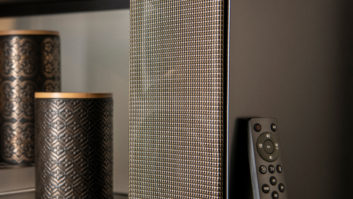Desperate Times Call For Desperate Measures As Integrators Dig Deep For Retrofit Work
Some people avoid retrofit installation projects at all costs. Others wear their abilities to deftly fish wire through walls, while sweet-talking the toughest of homeowners, like a badge of honor.
With the economy in the tank, new-home starts frozen in time, and consumer spending in suspended animation, many residential electronic systems

contractors (RESCs) are finally embracing retrofit and remodel projects.
For some, installing and integrating new technology in existing homes is the only work available. Others are not there yet, with new jobs still in the pipeline. In this zip code economy, the slower markets are acting fast and retro is in style. Despite its obvious potential, however, these kinds of projects present a whole new set of installation and business challenges.
HIGH-END HITS
You know the economy is bad when Eric Rossi’s market is down. The owner of Integrated Electronics in Danbury, Connecticut, Rossi serves the wealthy suburbs north of New York City. He said, that though most downturns have missed him in his 20 years in the industry, even some of his toptier clients are nervous and have “hunkered down” to weather this storm.
“Fortunately, I have a very strong high-end client base with long-term relationships—some going back 15 or more years,” Rossi said. “A lot of them are doing extensive renovation on their existing homes as opposed to building new ones. Renovation and upgrades are a big part of my business.” Rossi said that it’s important to learn how to shift to retro during a down economy. It opens up a lot of jobs that a strictly new-construction contractor would never do. “It allows you to really show the value of your labor, and justify your pricing. It separates you from the pack in certain markets,” he said.
David King, owner of King Systems LLC, in Lakewood, Colorado, noted that the advantage of retro work is that it’s abundant in nature and can be quickly completed. “There is typically not a long construction timeline, the home is readily available to begin work, and you don’t have to wait on a builder or other trades to complete their work before you can complete yours,” he said.

Lewis Franke (inset), systems designer for DM Home Entertainment, in Carrollton, Texas, has focused on retro projects since the downturn in new-home construction began, because high-end homeowners who have the money are staying put and spending more. One example is a recent whole-house project and showroom-quality media room remodel that came as a result of a client’s unwillingness to move during a down market. “I personally like retrofit projects because regardless of the size, you can get in and out without anything to stand in your way but your customer, yourself, and your installation team.”
John Prince, president of Atlantic Home Technologies, in Jacksonville, Florida, admits to “watching expenses like a hawk, working the AR, and being very choosy about taking jobs with gross profit percentage below our standards” during the down-turn. Prince said that he is turning away low-profit work, because, “now is not the time to buy market at the expense of margin.”
Retro jobs, he explained, are usually much less price sensitive than new construction, particularly production-home projects that were once AHT’s bread and butter. “In retro, we’re contracting with the owner, not the builder,” he added. “We write the SOW [standard of work] and contract, not the other way around like with builders.”
CHALLENGES AND PITFALLS
Lewis Franke, systems designer for DM Home Entertainment, in Carrollton, Texas, has focused on retro projects since the downturn in new-home construction began, because high-end homeowners who have the money are staying put and spending more. One example is a recent whole-house project and showroom-quality media room remodel that came as a result of a client’s unwillingness to move during a

The client stayed put and updated the media room, DVD distribution system, and house-wide audio system. The four-month project involved rewiring the entire media room for McIntosh Audio, Magnepan speakers, satellite, and a Fusion Research DVD Media Server. down market.
“The client stayed put and updated the media room, DVD distribution system, and house-wide audio system,” Franke said. The four-month project involved rewiring the entire media room for McIntosh Audio, Magnepan speakers, satellite, and a Fusion Research DVD Media Server. The house-wide audio system was changed to Control4 with the new seven-inch touch panels in the kitchen, game room and master bedroom.
Franke cites logistics as the number-one problem facing anyone attempting retro work.
“How do we get an existing structure to handle new technologies when there is a huge wall in the way? How do we get the house updated without too much reconstruction or damage?” he said. “Getting the infrastructure in place is tough. Sometimes we have to be creative, and a lot of times we are integrating newer wireless technologies we have been experimenting with that are allowing us real solutions.”
King agreed that a retrofit technician must know how to fish wires through walls, evaluate an existing home structure to determine cable pathways, navigate around electricity, and fixtures, and well as knowing how to navigate plumbing, HVAC, and other sub-systems that are installed throughout the home.
Prince agreed that retrofit technicians must possess a higher level skill-set to work on existing buildings and homes, but added that that it takes more time on the front end to do accurate estimates in retrofit work, and that the scope of work must be thorough and well documented.
JOB COSTING RETROFIT
Grayson Evans, an industry consultant and owner of The Training Dept., explained that job costing and resource management is different in retro work versus new-home projects. More time, he said, must be spent “up front” on planning and estimating the job. “Each job is unique and requires more attention to planning details,” Evans noted. “To do retrofit efficiently, everyone that works on the job needs good retrofit training, particularly on how to manage the people on the job. New skills must be developed.”
Rossi typically estimates at least three times the labor for a given retrofit job over what he charges for new homes. “It’s tough to price unless you can do T&M [time and materials contract] or give an estimated number,” he said.
Helen Heneveld, owner of training consultant Bedrock Learning, advises RESCs to not “firm bid” a project, because no one really knows what is behind the

The house-wide audio system was changed to Control4 with the new seven-inch touch panels in the kitchen, game room and master bedroom. walls. “Retrofit work can take two to four times longer,” she said. “Attention to detail while working in the customer’s home is paramount. You are now the ‘finish carpenter,’ not the ‘trim carpenter.”
Stone warned that unless a RESC keeps in constant contact with the client, he will have difficulty getting paid for every man hour, even when sold as time and materials.
Robert Ridenour, president of Connected Technologies, in Colorado Springs, Colorado, noted that his company has been “really good at large projects,” but that it takes a different mindset to do small ones. “There’s a lot of ‘we’ll take care of that next time we go out’ on large projects. Because you have maybe hundreds of hours of labor, you have a large buffer for labor and organization,” he explained. “On these smaller projects, if there is even one item missing or a detail missed on the work order, then you either have to go back or maybe reschedule entirely. That one call back could cost you the profit on a project.”
Franke added that in retrofit, nothing will hurt a business more than spending hours or days longer on a project that were not billed. “You must use experience, good estimating software, past projects, and proper efficiencies to gauge what each special project is going to entail,” he said.
GETTING THEIR DUCKS IN A ROW
Rick Montgomery, president of Home Technology Consultants in Watkinsville, Georgia, began his career performing a great majority of retrofit work. His company’s work has been largely new construction for the last 10 years and has not yet been changed by the downturn. He advised integrators who do plan to tackle retro work to first master the ability to fish wire into difficult places without damaging walls. He recommended recruiting an experienced installer from the alarm industry. “Those guys can fish wire just about anywhere,” he said.
Montgomery also advised owners to encourage their installers to appear clean cut and groomed, because they are going to be interacting with homeowners instead of other construction trades on retro job. “This includes making sure they clean up after themselves every day and don’t track in dirt,” he said. “They should leave the customer’s home cleaner than they found it.”
Rossi warned that not only the homeowner must be aware of the potential ramifications of retrofit, such as patching and painting, but that a salesperson must understand construction and know the limitations and liability of retrofit.
Stone said that there must be an expectation with the client up front about any disruptions to their home. “A lot of clients think retrofits can be completed with no dust, no fuss, no muss,” he said. “They need to be educated to the contrary. They need to be able to ballpark the labor portion of the job and have a written explanation of instances where a job can take longer to complete if they have any hope of collecting the additional labor over and above the ballpark estimate. They need to train their installers to adopt habits that will make raving fans of the client, reinforcing the client’s decision to select your firm.”
King agreed that installation crews must be retrained to be neat, clean, and sensitive to a customer’s time, children, and other living conditions that may affect whether or not it’s the right time to drill a hole, make a mess, or if they need hang plastic to protect precious furniture or household valuables from dust.
“Now more than ever they must know how to complete a project from start to finish in order to keep business going and their clients happy,” King said. “Completing a project doesn’t just mean hanging a flat-panel TV on the wall, installing speakers, and doing cable management. Completing a project means cleaning up after yourself, restoring the customer’s environment to its pre-installation state, educating the customer on how things operate, and creating follow up and service that is going to keep that customer around for life.”
Ridenour suggests a re-examination of your company’s product mix, because some products are much easier to retrofit than others. “Create a tool box of upgrades for your clients and have a proven solution for everything,” he said. “If a client calls you to replace a CD changer, pitch them on Sonos. If you have single-zone systems out there, talk to them about an MX-6000 and an iPod dock from [Universal Remote Control]. You need a way to turn any request into a value-added upgrade.”
Prince concluded that the mindset of every retrofit job is going to be different. “There are no more cookie-cutter home plans,” he said. “It’s profitable if you know the requirements, follow the rules, and do it right.”
Jeremy J. Glowacki is editorial director of Residential Systems.







